For Big Results Think Small
High-rise living, cluster-zoned developments, and an increasing scarcity of land are giving rise to a new class of farmer: the urban gardener. Using simple space-saving stratagems, city dwellers and suburbanites are growing an impressive variety of vegetables. With the help of intensive culture (very close planting) the yield per square foot can be multiplied. Intercropping and succession planting can also bring impressive increases in crop size. Where soil is poor or space extremely limited, you can get excellent results by raising vegetables in containers.
Lack of sunlight, as well as a shortage of space, often limits the kinds of plants an urban gardener can grow.
Crops that are raised for their fruits, such as tomatoes and cucumbers, need at least six hours of sunlight a day. Root crops, such as beets and turnips, can get along with less.
Lettuce and other leaf crops can be grown with as little as four hours a day of direct light. Best choices for the mini-garden are plants that give a high yield and take little space: leaf and salad crops, plus those that can be trained vertically.
The French Intensive Method
Developed nearly a century ago by French truck farmers, the French intensive method combines special soil preparation with heavy feedings of organic fertilizers to support a dense planting of vegetables.
To prepare the soil, first rototill or double-dig it (see The Kitchen Garden ). Then work compost or well-rotted manure into the soil until the top 12 inches are one-third to one-half organic matter. In clay soils build up the proportion of sand to one-third.
Adding these materials will increase the volume of your soil so that it forms a low mound, which aids drainage.
Rake the mound smooth; then top it with a 2-inch layer of manure plus a light sprinkling of bone-meal and wood ashes. Work these into the top 3 or 4 inches of soil and rake smooth. (For succession crops repeat this feeding each time a crop is replaced.) Soak the soil deeply a day or two before you sow seeds or set out transplants and mark off the areas where you plan to plant each vegetable. Spread seeds thinly in their designated areas. As the seedlings grow, thin them to about half the spacing recommended for an ordinary garden. A laborsaving trick is to drag a steel rake lightly across them when they are 1 inch tall; thin by hand later.
Large seeds, such as peas and beans, can be sown so that no thinning will be necessary later. Transplants of tomatoes and other large vegetables should be set a little more than half as far apart as in an ordinary garden.
Leafy vegetables, such as lettuce and Swiss chard, should be left close enough for their leaves to form a continuous canopy over the soil, thus shading out weeds, conserving moisture, and creating a favorable microclimate for plant growth.
Careful soil preparation and dense planting are the keys to success with the French intensive method: (1) Gardener works organic matter into well-loosened soil. (2) The soil is raked into a smooth mound. (3) seeds are broadcast thinly (not sow n in row s) to cover the soil. (4) The resulting crop forms a soil-protecting canopy with its densely growing leaves.
Raised Beds and Planters
Raised beds, originally developed to cope with infertile or poorly drained soils, are increasingly popular. They are convenient for planting, weeding, and other garden tasks; they give excellent drainage; and they warm up, several weeks ahead of regular garden plots in the spring.
For best results, raised beds should be at least 12 inches high. Fill them with enriched garden soil or a special mix, such as the one described on the next page. If the soil level is kept 2 or 3 inches below the top of the beds, they can be covered with glass and made to serve as cold frames.
When a bed runs along a wall or is otherwise accessible from only one side, it should be no more than 3 feet wide so that you can tend it without having to step on the soil. When both sides are accessible, the width may be up to 6 feet.
Raised beds may be any length desired, but they are easier to manage when they are short. Popular sizes are 4 by 4 feet and 3 by 9 feet.
Farming in Containers
Container gardening is one of the most efficient methods for growing vegetables in limited space. Almost any vegetable can be grown in a container-even corn or pumpkins-although plants that take up a great deal of space are not practical. Miniature varieties of vegetables are especially suited to container growing: they require less space than full-sized varieties and mature earlier.
Many vegetables can be container-raised indoors as well as outdoors. Leaf crops can be grown indoors even in winter with the aid of fluorescent lights. Fruit crops, such as tomatoes, can be grown indoors but need warm temperatures and at least six hours of summer sunlight.
Most root crops, however, are best grown outdoors.
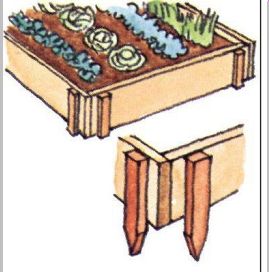
----------- Raised beds can be made of treated 2-in.-thick boards held
in place by stakes or fastened at the corners with angle irons. if 2 × 12 boards
are not available, combine narrow er boards to gain the needed height. The
higher the bed, the less stooping is required to tend the plants.
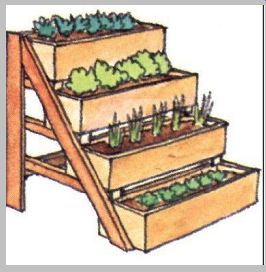
---------- Stepped boxes, a variant of the raised bed, give plants better
exposure to sunlight and can be tucked in a corner or against a wall. The separate
levels are easy to tend.
Boxes and stand can be made separately for easy disassembly and moving.
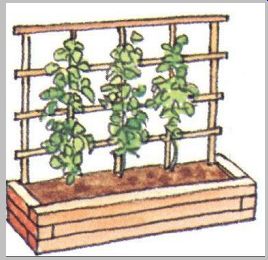
------ Narrow strip beside the house is thriftily utilized with a raised
bed made of railroad ties. Pole beans or other climbers are trained up a trellis
for maximum sunlight.
The bed can also be made of brick, stone, concrete, or cement blocks. Whatever material is used, be sure drainage is adequate.
----------------------
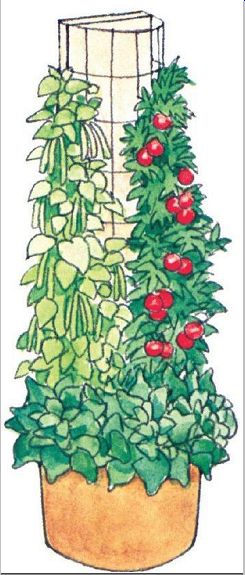
---------- Salad tree is made of long shelf board and semicircle of wire
with tub to hold planting mix.
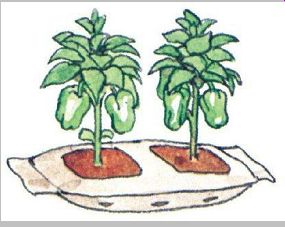
---------Bag of planting mix becomes instant planter.
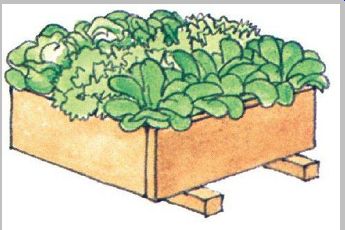
Box planter is easily built of new or scrap lumber and can rest on stringers
or feet.
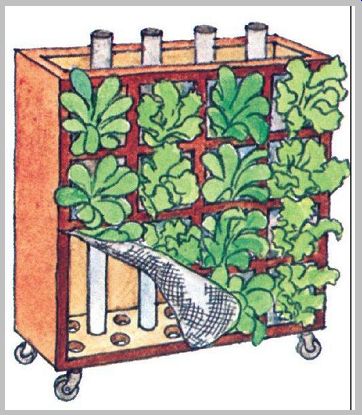
----------Many variations of the container idea are possible. The movable
bookcase-type planter shown above holds several levels of plants growing in
slits in its wire or plastic lining. Water and fertilizer are supplied through
perforated pipes. Casters make the planter easy to move, an idea that is adaptable
to other heavy, bulky containers.
------------------
Almost any sturdy, water-resistant receptacle can be used for container gardening: plastic or galvanized iron garbage cans, redwood planters, 2-gallon or 5-gallon buckets, even a plastic garbage bag. Of course, any type of container must be provided with holes for drainage.
Recommended practice is to drill drainage holes just above the bottom rather than in it.
For best results, use an artificial planting medium rather than garden soil. Artificial mixtures do not compact, even after repeated waterings, and they are much lighter in weight than soil. As a result, it is much easier to move the containers, an important feature since one of the advantages of raising vegetables in containers is that they can be shifted indoors on a cold night or around the yard to follow the sun. A good homemade mix can be made from peat moss, vermiculite (or perlite), and fertilizer. To make 1 gallon of mix, use 1/2 gallon peat moss, 1/2 gallon vermiculite, 1 teaspoon lime, 1 1/2 teaspoons of 5-10-10 fertilizer, and 1/2 teaspoon superphosphate. About 9 gallons of mix will fill a bushel container.
Because of the intensive care they get, container-grown plants can be spaced much closer together than if they were planted in an ordinary garden. The chart at right gives recommended space and soil allowances for a number of popular vegetables.
Plants grown in containers need watering more frequently than they would in a garden-as often as once a day in hot, dry weather. To check for moisture, probe the top 2 inches of soil with your finger. If the soil is dry, soak it thoroughly until water runs out at the bottom of the container. You should also add fertilizer every three weeks.
Use light doses, however; over-fertilizing can damage or kill plants that are grown in containers.
Windowsill Farming Indoors and Out
Apartment dwellers can use windowsills, balconies, and rooftops to raise surprisingly large crops of homegrown vegetables. According to one expert, as many as 100 carrots, 50 beets, and 50 cherry tomatoes can be harvested from a dozen 8-inch pots.
The most practical vegetables for the windowsill farmer are those that need little space and give high yields. The nature of your space also determines what you can grow. If you have balcony or rooftop space, climbers-such as standard tomatoes, pole beans, and cucumbers-are practical. For a windowsill concentrate on such low-growing vegetables as lettuce, spinach, carrots, and dwarf tomatoes.
Daylight exposure is also important, since indoor plants have the same needs for light and warmth as those grown outdoors. For an east-facing window the choice is limited to leafy vegetables and radishes. Southern and western windows are suitable for most vegetables. Warmth lovers, such as tomatoes and beans, do best in a southern exposure. A northern window is unsuitable for vegetables unless artificial lighting is provided as a supplement.
Selected vegetables for containers
================
Vegetable | Minimum container size | Number of plants per container
Beans (bush)
2 gal.
6 plants; in larger containers space 2”-3” apart
Beans (pole)
4 gal. 6 plants
Beets 1 pt.
2-3 plants; in larger containers space 2” apart
Broccoli 5 gal. 1 plant
Brussels sprouts
5 gal. 1 plant
Cabbage 5 gal.
1 plant; in larger containers space 12” apart
Chinese cabbage
1 gal. 1 plant
Carrots 1 pt.
3-4 plants; in larger containers space 1”-2” apart
Corn 10 gal.
4 plants; space 4” apart.
Plant at least 12 for pollination
Cucumbers 5 gal. 2 plants. Train vertically
Eggplant 5 gal. 1 plant
Kale 5 gal.
3-4 plants; in larger containers space 16” apart
Lettuce 1/2 gal.
1 plant; in larger containers
space 10” apart
Mustard greens
1 pt.
1 plant; in larger containers
space 4” apart
New Zealand spinach
2 gal.
1 plant (good for hanging basket)
Onions 1/2 gal.
16 green onions. For full-sized onions use larger containers; space 2”-3” apart
Peppers 2 gal. 1 plant
Radishes 1 pt.
4-5 plants per pot; in larger
containers space 1” apart
spinach 1 pt.
1 plant per pot; in larger containers space 5” apart
summer squash and zucchini
5 gal. 1 plant swiss chard
3 1/2 gal.
4-5 plants; in larger containers space 8” apart
Tomatoes (dwarf)
5 gal. 1 plant
Tomatoes (standard)
1 1/2 qt. 1 plant
Turnips 5 gal. space 2” apart
==============
Gardening Under Lights
Vegetables need ample light to flourish, especially rays from the blue and red ends of the spectrum. Normally these rays are supplied by the sun, but fluorescent tubes can take the place of natural sunlight. An equal number of cool-white (rich in blue) and warm-white or natural tubes (rich in red) seem to give the best result. Tubes especially designed for indoor gardening, high in both blue and red wavelengths, are also available.
Some growers use incandescent lamps to augment the red end of the spectrum, but these consume much more electricity for the light produced. In addition, they must be used with caution because of the heat they generate.
Fluorescent tubes should be positioned 6 to 12 inches above the plants: light intensity diminishes rapidly as distance increases. A fixture with four 4-foot tubes provides enough light for a 3- by 4-foot area.
Vegetables require 13 to 18 hours of artificial light per day. They also need a resting period of darkness. Leafy and root vegetables are easiest to grow under lights; tomatoes require extra care.
===========
What to grow where
For the windowsill:
Carrots Radishes
Cress spinach
Lettuce Tomatoes
Mustard Zucchini
For balcony, rooftop, or windowbox:
Any windowsill vegetables plus:
Beans Peppers
Broccoli Potatoes
Brussels squash
sprouts Tomatoes
Cabbage Turnips,
Corn other root
Cucumbers vegetables
Indoors under lights:
Beets Cucumbers
Carrots Endive
Celery Onions
Chinese Radishes cabbage Watercress
==================
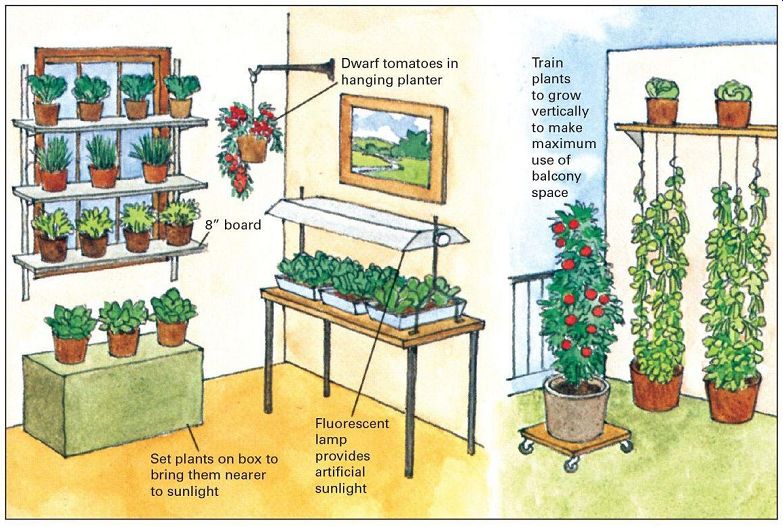
--------- Growing space can be increased by a number of simple expedients.
You can widen a window sill to hold more containers by adding an 8-in. board
supported by brackets. Most window s can accommodate two or three boards placed
across them, again supported by brackets.
Hanging containers are fine for dwarf tomatoes, but be sure not to make them too heavy for their supports. Bulky plants can be placed on a table in front of the window or on an up-ended box on the floor to raise them to window level. Unused bureau tops, tables, bookshelves, and even closets become planting areas with the aid of easily installed fluorescent light fixtures. On a balcony or other outdoor area you can make use of vertical space by training vegetables on stakes, strings, or against a wall as well as by using hanging containers and wall brackets.
===